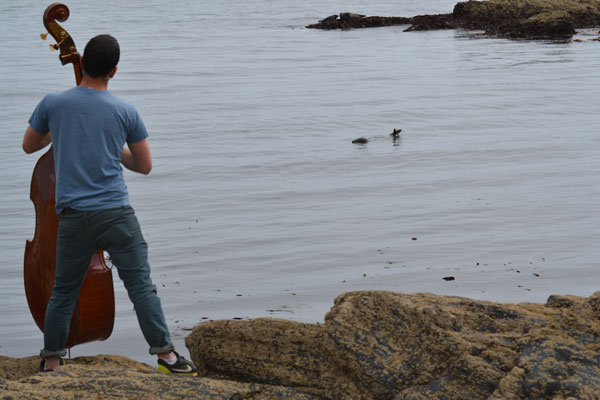Bob Earll ‘We were watching the grey seals hauled out at Great Sleadon rocks, near Start Point, in Devon last Sunday. About 15 animals were hauled out and basking on several rocks. It was a sunny day and this site next to the coastal path attracts lots of different visitors. In the hour or so we watched the seals had to contend with a group of four coasteerers, a drone flown over their haul out, and a group of 15 kayaks. They responded with a mixture of indifference and inquisitiveness. But taking the summer silly season to a new level the winner of the prize for most imaginative interaction was this chap with his double bass. Several of the seals moaned sympathetically but one simply could not resist getting closer!
The Zoological Society of London (ZSL) have caught the news this week with the results of their long running studies of marine mammals on the Thames revealing very significant populations of harbour seals
The Zoological Society of London (ZSL) has received records of 2,732 animals over that period.
Seals were the most common animal seen, with many spotted around London’s Canary Wharf, probably because many people spot them from its skyscrapers. In addition, the public reported 444 porpoises and dolphins on the river, and 49 whales.
The Thames Estuary is home to harbour seals, also known as ‘common seals’, and grey seals, but they are some of the least understood seal populations in the country. ZSL is using seal telemetry (tagging), annual population surveys and a public marine mammal sighting survey to gather data to better inform conservation and management. This information will form an integral part of the newly formed Greater Thames Seal Working Group. Annual Harbour Seal Population Survey In August of each year, ZSL carry out a harbour seal population survey in the Greater Thames Estuary using a combination of aerial, boat and land-based transects. The survey covers from Felixstowe (Suffolk) to Deal (Kent) and is timed to coincide with the harbour seal moult period, where seals spend a greater proportion of their time hauled out on sand banks.
Why we are there Research conducted by the Sea Mammal Research Unit (SMRU), has shown dramatic declines in some Scottish harbour seal populations. The reason for these declines is unknown and may be as a result of shifting prey species, disease, disturbance or competition with the grey seal. The Thames Estuary harbour seal population is becoming increasingly important at a national level and represents 12% of the English harbour seal population, but is one of the least understood seal populations in the country.
